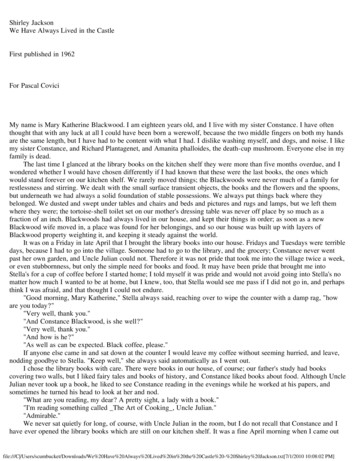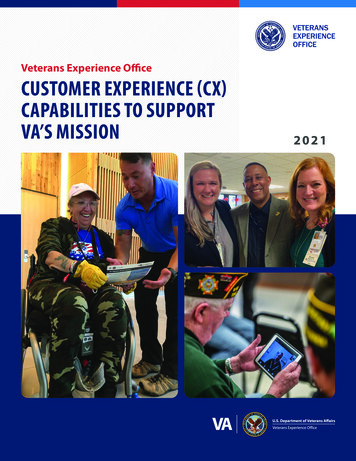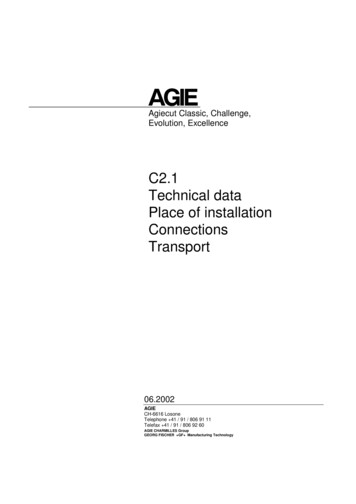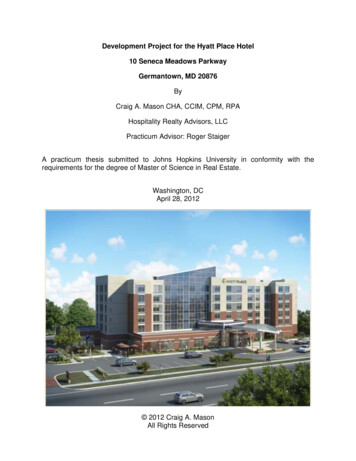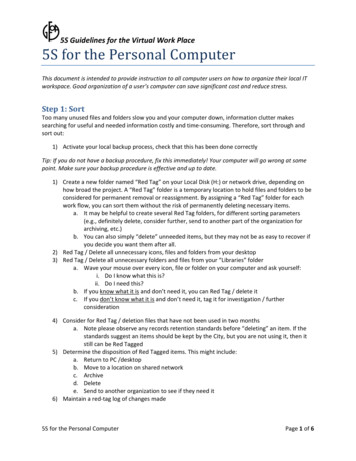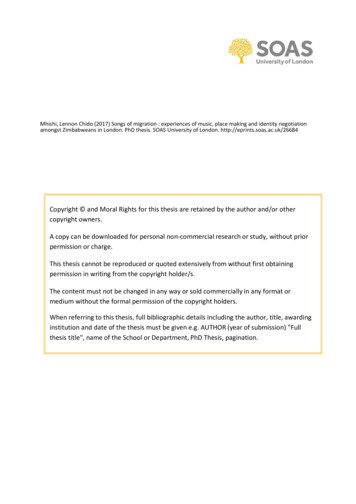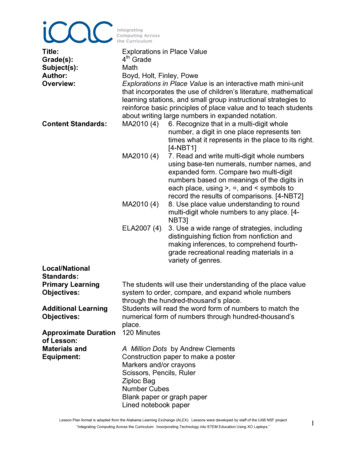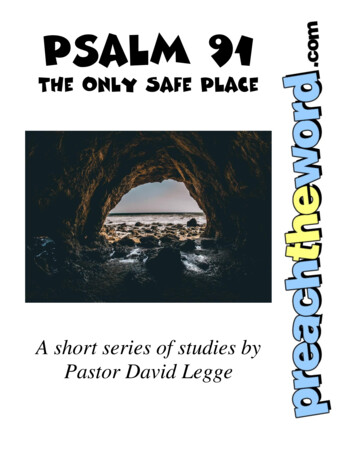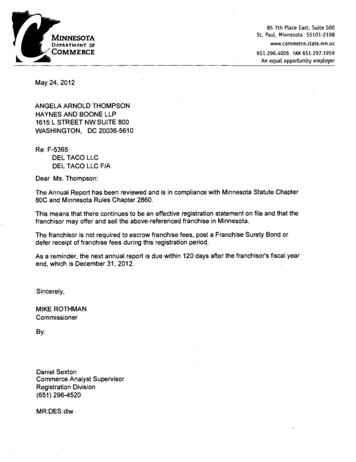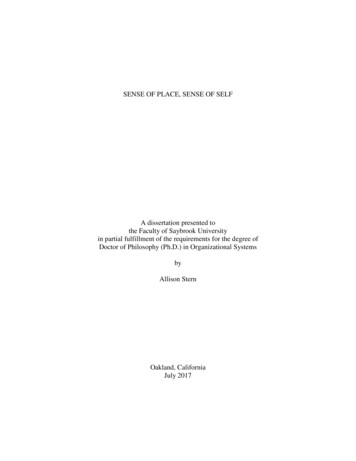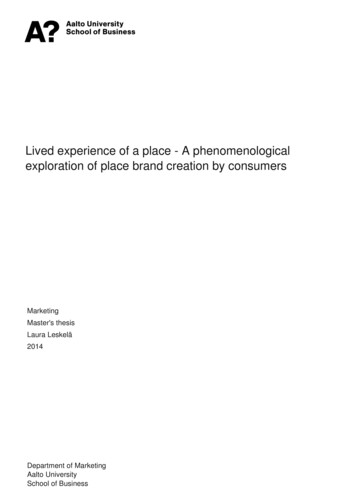
Transcription
Lived experience of a place - A phenomenologicalexploration of place brand creation by consumersMarketingMaster's thesisLaura Leskelä2014Department of MarketingAalto UniversitySchool of BusinessPowered by TCPDF (www.tcpdf.org)
Author Laura LeskeläTitle of thesis Lived experience of a place – A phenomenological exploration of place brandcreation by consumersDegree Master of Science in Economics and Business AdministrationDegree programme MarketingThesis advisor(s) Sammy ToyokiYear of approval 2014Number of pages 88Language EnglishAbstractOBJECTIVES OF THE STUDYThis study sheds light on co-creative place branding by approaching place brands from the grassrootslevel of lived experiences upwards. A place brand is seen as negotiation between culture, identity,and image that are simultaneously constructed and consumed in the level of lived experience. Thisidentity-based view brings more dynamism to place branding by highlighting the power of actorsand networks in constructing and consuming meanings. Place is understood as an ecosystem wheredifferent groups co-creatively build and negotiate place identity and the place’s brand. The studyshows how experiences in our everyday environment contribute to the experienced sense of place asplace identity, and further to a wider place brand experience.METHODOLOGYThis study is qualitative, and conducted in Helsinki Airport within a research period of three weeks.A total of 50 interviews were carried out. The interviews followed phenomenological interviewmethods. In addition, ethnography as a method was utilized in studying the environment.FINDINGSThe findings display how sense of place is negotiated in the multidimensional system of a placethrough its specific experiential dimensions, that in the airport are specified as competence,regulation and control, people, time, space, and experienced agency. These dimensions incorporateenabling and constraining features that guide the formation of experience, and thus of an airport’ssense of place. A positive sense of place on a pre-reflective level is established when the environmentsupports the nature of human being-in-the-world. The conditions of successful place branding dealwith optimizing the goals of a place ecosystem to support this nature of being, by understanding aplace as a field of affordances that should maximize the possibility to redeem positive experiences.In practice, this study gives implications on how an environment should nurture and support thedirected, temporal and inherently embodied nature of being. It also portrays the co-creative natureof the place ecosystem an airport hosts, showing how consumers co-creatively participate in the valuecreation and determine the actualized value-in-use phenomenologically in the surface of livedexperience.Keywords place branding, place co-creation, place identity, sense of place, place ecosystem,phenomenology, embodiment
ACKNOWLEDGEMENTSI would like to thank Helsinki Metropolitan Region Urban Research Program and theparticipating partners for supporting my research. This Master’s Thesis is contributing to theMetropolitan Brand-project. Special thanks to my thesis advisor Sammy Toyoki for valuableguidance and support.2
Table of Contents1. Introduction . 51.1. Research objectives . 71.2. Structure of the thesis . 92. Literature Review . 112.1. What are we talking about? Definitions of a place brand and place branding . 112.2 Co-creating a place brand . 152.2.1. Co-creation and multilogue inside a place ecosystem. 162.2.2. Identity-based place branding . 202.2.3. Place identity as sense of place. 222.3. A phenomenological account on experience in a place . 262.3.1. Humans as living subjects . 272.3.2. Intersubjectivity . 282.3.3. Directedness . 292.3.4. Embodied existence . 302.3.5. Agency and affordances . 322.4. Synthesis of the literature . 343. Methodology . 363.1. Interpretive approach in qualitative research . 363.2. Methods. 373.2.1. (Auto-)Ethnography. 373.2.2. Phenomenological interviews . 393.3. Data collection, respondents and analysis . 403.4. Helsinki Airport as a setting . 414. Findings: establishing a sense of place through an airport experience. 434.1. First stages of the airport experience . 444.1.1. Competence . 444.1.2. Regulation and control . 484.2. In the transitional period between coming from and going to . 554.2.1. People (me and others) . 554.2.2. Time . 614.3. Airport space . 654.3.1. Space . 664.3.2. Experienced agency. 683
4.4. The experiential dimensions in establishing a sense of place . 705. Discussion . 746. Conclusion, limitations and future research . 814
1. IntroductionDue to the highly globalized and mobilized world of today, the relevance of, and interest in placebranding has grown vastly in recent decades (Kavaratzis & Hatch 2013; Kavaratzis & Ashworth2010). It is no longer enough that a place, such as a nation, region or a city, has its own identity:the boundless world created through e.g. explosion in means of communication technologies hasturbulently changed the world to a global, interconnected arena of competitive forces (Kavaratzis& Ashworth 2010; Govers & Go 2009). Not only does this affect businesses operating in the newenvironment, but also countries, regions and cities trying to manage the insecure surroundings.The attempts of assuring the evermore-moving masses of possible investors, tourists, employers,employees and inhabitants to consider residency or visitation have become a dominantphenomenon in the global bid to gain access to resource flows. (e.g. Kotler & Gertner 2002;Papadopoulous 2004; Gertner 2011.) Just as important it is to assure the current inhabitants,whether businesses or citizens, that the place they are located in is satisfying (Kavaratzis 2005;Colomb & Kalandides 2010).Place branding poses marketers with multiple challenges: the variables and determinant factorsare not, unlike in traditional marketing, under marketers’ direct control (Papadopoulous &Heslop 2002) and it is difficult to define the “ownership” of a place and its brand. The uniquechallenges of branding a geographic entity stem from its interconnectivity with its surroundings:one can think of multiple seemingly uncontrollable factors jumbling the balance at a quick pace,on any given moment (e.g. natural disasters, politics and media). Building a coherent place brandrequires extensive co-operation among multiple actors and organizations, such as governments,tourist organizations, businesses and residents in order to create streamlined communication aswell as efficient, cohesive delivery of the brand promises. (Balakrishnan 2009; Moilanen &Rainisto 2009; Warnaby 2009; Kavaratzis & Ashworth 2010.) Although this need forcommunication between different stakeholder groups has been noted in the literature, placebranding is still considered rather top-down controlled (Aitken & Campelo 2011; Warnaby &Medway 2013).Top-down projected place brands have in practice proven to be perceived as vague and forced,and have resulted as inauthentic projections of a place (Aitken & Campelo 2011) and led to5
perceived “sameness” of places (Warnaby & Medway 2013). A recent contribution towardsanswering the challenges in place branding has been to, in a multidisciplinary manner, tieconcepts from other areas of research to place branding in order to make sense of how meaningsare co-creatively built among different stakeholder groups. One such interesting effort iscombining the ideas of service-dominant logic and co-creation to place brands. Warnaby (2009)for instance attempts to answer to the challenge of “place products’” and place branding’scomplexity through interweaving notions from service-dominant logic of marketing (originallydeveloped by Vargo & Lusch 2004), suggesting places form their own unique product wheredifferent actors in an ecosystem collaboratively produce value propositions that are realized inlived experience, where consumers determine the actualized value-in-use of a place. Identitybased place branding (Kavaratzis & Hatch 2013) is also a recent contribution to place brandingliterature, closely dealing with co-creation and encouraging multi-stakeholder dialogue inunderstanding how place identity iteratively and dynamically develops, concurrently thusdeveloping and shaping a place brand. These viewpoints bring depth to place branding literature,as place identity as a starting point shifts the power in creating a place brand from place brandmanagers to a larger group of actors: consumers, citizens, institutions and corporate actors in aplace (Govers & Go 2009, 3).As the perspective on place branding is revised to reflections rising bottom-up from the grassrootlevel upwards, it makes sense that different groups and actors co-actively build, negotiate anddevelop a place’s culture and image and thus identity in the lived environment (Kavaratzis &Hatch 2013). Including the notion of place identity as a central concept in place branding bringsmore dynamism to attempted theorizations, as it shifts the power in place branding to thesystems of networks of actors residing in a place, and highlights these networks in the creationof meanings (Govers & Go 2009, 3). The difficulty, however, proves to be in actually studying thisco-construction: the gaps noted in current place branding literature deal with the vaguenesssurrounding co-creative and participatory place branding. As place brand, place identity and thenotion of place itself are rather fuzzy and interwoven concepts, it is difficult to accurately pindown and separate their formation. Current literature has also promoted a rather static view onplace identity (Kalandides 2011; Kavaratzis & Hatch 2013). Further, there is little empiric researchattempting to display how the negotiation and interwoven dialogue in constructing meanings ina place occurs in reality. When considering how sense of place as place identity (Kalandides 2011)6
forms, practical evidence of constructing and consuming meanings in lived experience andenvironment would bring depth and clarity to the concepts still difficult to define. Kavaratzis andHatch (2013) for instance assert that it would be useful to understand how place culture iscollectively created and lived in a place, as this understanding would advance the perception ofplace identity formation through place culture, calling for further elaborations on co-creativeplace branding theory and the roles of stakeholder groups.Places are much like services, in that they too are simultaneously produced and consumed(Govers & Go 2009, 7; Rakic & Chambers 2012). In order to gain a deeper understanding and newperspectives on how different stakeholder groups actively participate in the dialogic discussionand negotiation of constructing and consuming sense of place and place meanings (Govers & Go2009; Rakic & Chambers 2012), the viewpoint on philos
place identity (Kalandides 2011; Kavaratzis & Hatch 2013). Further, there is little empiric research attempting to display how the negotiation and interwoven dialogue in constructing meanings in a place occurs in reality. When considering how sense of place as place identity (Kalandides 2011) 7 forms, practical evidence of constructing and consuming meanings in lived experience and environment .

